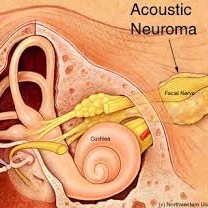We’re Going Deep Today
I posted a blog here several months ago, questioning the benefits of vHIT (video Head Impulse Test) as it relates to vestibular compensation. At that time, I had not had much exposure to vHIT, but was very familiar with informal, non-computerized head impulse testing. In my new position, I now have vHIT available, so have been playing around with it. A recent conversation with a Neuro-otologist in my new setting triggered some thought provoking reading. So, I will share. This will be a ramble intended only for vestibular professionals.
A 2014 study looked at changes in gain and latency of the VOR, as measured by vhIT, immediately following removal (nerve section) of a unilateral vestibular schwannoma (also known as Acoustic Neuroma). They compared vHIT results, lesion versus non lesion side, both before and after surgery. Most of what they found was predictable based on what we (or at least I) believe about the consequences of a sudden decrease in output from one labyrinth.
Here are some of their findings:
- VOR gain on the lesion side pre-op was less than normal and less than the non-lesion side. That makes sense as the vestibular nerve is compromised on the lesion side, disrupting output from the labyrinth.
- VOR gain on the non-lesion side pre-op was essentially normal. Again, this is expected as the non-lesion, healthy side should be able to handle impulsive head movements in that direction.
- After nerve section, the VOR gain on the lesion (now sectioned) side dropped dramatically. This is also expected due to lack of response from the lesioned (sectioned) side. The labyrinth is no longer connected to the brainstem.
- The gain on the non-lesion side also dropped significantly, but not dramatically; gradually decreasing over 3 to 4 days. This is evidence of the phenomena of “cerebellar clamp” where the brain dampens it’s connection to the healthy side after a sudden decrease in function on the lesion side. The goal of cerebellar clamp is presumed to be to reduce the symptom inducing asymmetry caused by the sudden loss on the lesioned side.
Okay, for those of you that have stuck with me (and I forgive those of you that have not; keep in mind, I did a piece on Taylor Swift Induced Vertigo just two weeks ago), here’s the part that I found most interesting. They found very low grade (not even out of the range of normal) spontaneous nystagmus in darkness just one day after nerve section. This surprised me because patients with acute vestibular neuritis generally have fairly intense nystagmus in darkness for at least a few days. The authors suggest that this finding may be due to some level of compensation occurring prior to the surgery as the schwannoma increased in size. This makes perfect sense, as we have believed for a long time that patients with vestibular nerve tumors rarely complain of vertigo because they are gradually compensating as the tumor grows and further disrupts the responsiveness of the labyrinth.
For the three of you that made it to the end of this post, I salute you.
Photo courtesy of American Hearing Research Foundation







